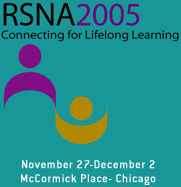
Abstract Archives of the RSNA, 2005
Teresa Abbattista, Presenter: Nothing to Disclose
Francesco Ridolfi, Abstract Co-Author: Nothing to Disclose
Eugenio Brunelli, Abstract Co-Author: Nothing to Disclose
Paolo Busilacchi, Abstract Co-Author: Nothing to Disclose
Vascular derangement and hyperdynamic circulation develop early in chronic liver diseases. Standard ultrasonography associated with Doppler study of splanchnic vessels are neither sensitive nor specific enough to assess chronic liver disease severity.
Aim of the study was to evaluate whether second generation ultrasound contrast agents can grade diffuse liver disease severity.
Forty-three patients (28 males, mean age 55.5 years) were enrolled: 14 patients with clinical and/or histological diagnosis of liver cirrhosis, 19 patients with histological proved non-cirrhotic diffuse liver disease, 10 patients without liver disease. After a standard ultrasound examination, a bolus injection of 2.5 ml of Sonovue® (Bracco spa, Milan, Italy) was given intravenously followed by a saline flush. The intensity of the Doppler trace of middle hepatic vein was recorded from 20 seconds before to 2 minutes after SonoVue® injection. Arrival Time (AT) was defined as the time when signal began to increase after the injection of SonoVue®, whereas Peak Time (PT) as the time of maximum signal analyzed.
No side effects related to SonoVue® injection were observed. AT was lower in cirrhotic patients compared to patients with non-cirrhotic liver disease and to patients without liver disease (13.3 ± 2.9 seconds vs. 21.6 ± 3.6 seconds and vs. 25 ± 4 seconds respectively, p< 0.05). AT was lower in absence of porto-systemic shunts such as esophageal varices (12.3 ± 2.7 seconds vs. 15.2 ± 1.6 seconds, p< 0.05). Moreover raw data obtained from the cirrhotic group showed that AT ≤ 17 seconds represents a cut-off distinguishing patients with liver cirrhosis from non-cirrhotic ones with a sensibility of 100% and a specificity of 93%. No statistically significant differences were found about PT among the three groups.
Analysis of liver first-passage by ultrasound contrast agents is safe and easy to perform. Contrast-enhanced hepatic ultrasound could represent a useful non-invasive tool to grade severity of liver diseases.
Abbattista, T,
Ridolfi, F,
Brunelli, E,
Busilacchi, P,
Grading Severity of Chronic Liver Diseases by Contrast-enhanced Ultrasound. Radiological Society of North America 2005 Scientific Assembly and Annual Meeting, November 27 - December 2, 2005 ,Chicago IL.
http://archive.rsna.org/2005/4420233.html

